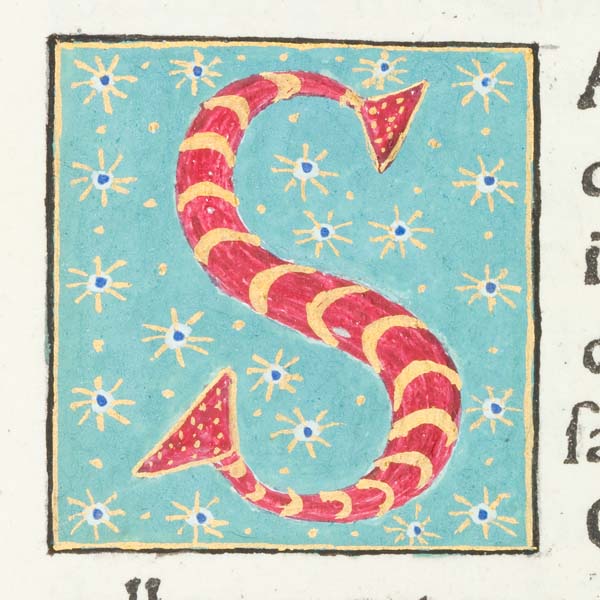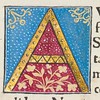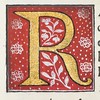Scriptores historiae Augustae.
Edited by Bonus Accursius.
Contents: Gaius Suetonius Tranquillus: Vitae XII Caesarum; Aelius Spartianus: De vita Hadriani; Julius Capitolinus, Vulcatius Gallicanus, Aelius Lampridius, Trabellius Pollio and Flavius Vopiscus: De regum ac imperatorum Romanorum vita; Eutropius and Paulus Diaconus: Historia Romana.
Milan: Philippus de Lavagnia, 1475.
Fol. 2 vols. Part I: A10 B-M8 N-O6; Part II: 2A6 2B-R8 2S10 3A-E8 3F10. [304] leaves. A1, O6, 2A1, 2S10, 3F9, 3F10 are blank leaves.
In two parts, dated: I) 20 July 1475; II) 22 Dec. 1475.
ISTC is00340000; GW M44203; Goff S340; BMC VI 702 (IB. 26112); Bod-inc S-117; CIBN S-487; BSB-Ink S-229.
| GIP number: | S19 |
| Shelf-mark: | Sp Coll Hunterian Ds.2.6-7 (see main library entry for this item) |
| Note: | Printer's pin-holes visible. |
| Provenance: | Edward Harley (1689-1741), Lord Harley; from 1724 2nd Earl of Oxford: see Binding. Thomas Osborne (d. 1767), bookseller: purchased all the Harleian printed books; no. 4711 in his 'Catalogus bibliothecae Harleianae', vol. 1 (London: 1743) and no. 1147 in vol. 3 (London: 1744). Anthony Askew (1722-1774), physician and classical scholar: Askew sale, 13 Feb. 1775 onwards; lot 1932 in 'Bibliotheca Askeviana …' (London: Baker & Leigh, 1775). William Hunter (1718-1783), physician and anatomist: purchased by Hunter at the Askew sale for £23.10.0 according to the annotated copy of the Askew sale catalogue in University of Glasgow Library (shelfmark Mu36-c.8). University of Glasgow: Hunterian bequest, 1807; Hunterian Museum bookplate on front pastedown of each volume, with former shelfmarks Ag.6.14 and Ag.6.15. |
| Binding: | England, 18th-century gold-tooled red goatskin, bound for Lord Harley by an unidentified binder. On the covers of both volumes triple fillets form two concentric frames: within the outer frame is an ornamental roll, and within the inner frame an ornamental roll containing fleur-de-lys and feather-shaped motifs. Each cover has a lozenge-shaped centre-piece, made up of several individual tools; gilt turn-ins. Both volumes rebacked; original spine coverings not preserved or recorded. Some of the tools used show similarities with the Chapman and Elliott tools illustrated in Nixon, ‘Harleian bindings’, pls 14 & 15, but none is identical. Gilt-edged leaves; marbled endpapers. Size: 338 x 237 mm. |
| Leaf size: | 328 x 227 mm. |
| Annotations: | Early marginal annotations (mostly so heavily washed out as to be unreadable) on some leaves; two lines of Greek in an early hand inserted on A10v; 18th-century shelfmarks “232 H-5” and “233 H-5” written in ink on verso of front free endpapers respectively. |
| Decoration: | On A6r a seven-line illuminated initial “A” in red, blue and brown on a gold square ground with floral decoration; from the initial there extends into the inner margin a border of a gold ground decorated with flowers in blue, pink and green; the square ground of the initial and the border are edged with black. A similar six-line illuminated initial “O” on 2B1r of Part II. Numerous illuminated initials throughout, particularly in Part II, mostly decorated with floral motifs but occasionally with a purely geometric pattern. The illuminations appear to be 15th/16th-century north Italian. |
| Imperfections: | Wanting the first blank leaf and the final blank leaf of Part I, the first blank leaf and the final two blank leaves of Part II; the signatures are placed far down in the lower right-hand corner of the page and in this copy many have been cropped by the binder. |
More images from this book
All the decorated images from this book have been digitised and are available via our flickr set.






